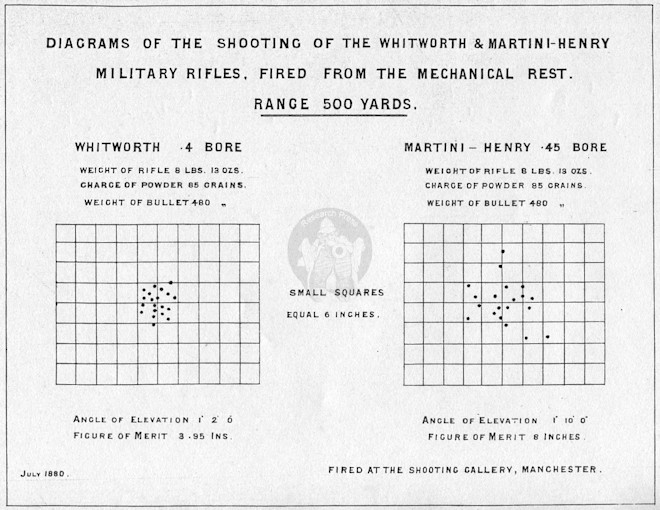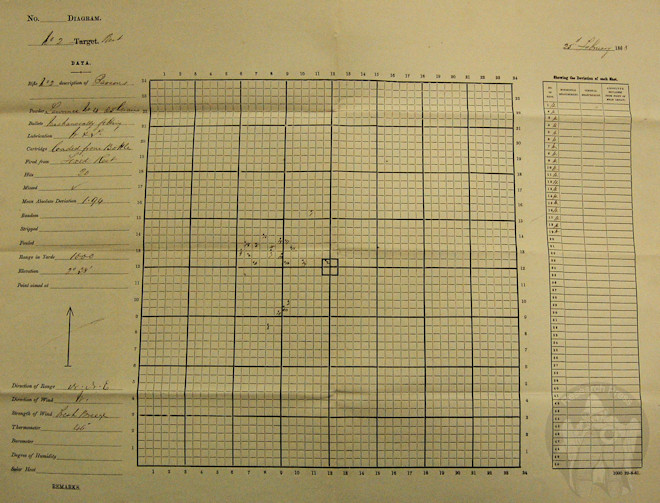You are here: Home > Firearms > British Military Longarms > Small Arms Trials
Written by: David Minshall
The 19th saw firearms evolve from flintlock muzzle loaders, using patched round ball and black powder, through to bolt action breech loaders with smokeless powders. As firearms development proceeded, so arms and ammunition needed assessing in comparative trials by the military. In the 1860s the National Rifle Association held competitive trials to determine which rifle would be used in the final stage of the Queen’s Prize at their Annual Rifle Meetings on Wimbledon Common. The system used to measure precision of rifled arms at this time was the “Figure of Merit”.
During the 1850s and early 1860s there was keen interest in the relative merits of the Enfield and Whitworth rifles, with newspapers reporting on experiments. One such example is that published in The Times of 23 April 1857, an extract of which appears below.

The following diagram from Sir Joseph Whitworth’s ‘Papers on Mechanical Subjects’ compares the Whitworth with the Martini-Henry at 500 yards. Note that the small squares in the diagram equal six inches. So, for the Whitworth with a Figure of Merit of 3.95 inches, the group size is in excess of 12 inches (ie. 3 times the FoM), while for the Martini-Henry with a Figure of Merit of 8 inches the group size is approximately 30 inch diameter (ie. 3.8 times the FoM).

So just what is Figure of Merit? The following explanation is taken from the ‘Report of the Enfield and Whitworth Committee’, published in April 1861.
39. It is necessary here to point out that the following plan has been adopted to determine what is called the figure of merit, or the mean radial distance of shots from centre of group.
40. The horizontal distance of each shot upon the target, from a fixed vertical base, is first found, and a mean horizontal distance obtained.
41. The same process is followed to obtain a mean vertical distance from a fixed horizontal base. The intersection of two lines drawn parallel to, and at distances equal to the horizontal and vertical mean distances from the bases, give what is termed the point of mean impact.
42. The distance of each shot upon the target from this point is noted, and, in the case of those recorded as misses, the distance is taken as equal to one-half the diagonal of the target.
43. The whole of these distances, determined as above, are added together, and divided by the number of shots fired, and the result is termed the figure of merit, or mean radial distance of shots from centre of group.
44. The Committee beg to observe that the results obtained by the above method, when there are any misses, only approximate to the truth, for every miss is assumed to lie at a distance of one-half a diagonal of the target from the point of mean impact. In fact it may happen, in an extreme case, that the best figure of merit is obtained by the gun that has the greatest number of misses, although these misses may be random shots.
45. Also, that in some cases these results are calculated to give, without an inspection of the target, an erroneous impression as regards the accuracy of shooting. For instance, if the grouping is near one edge, or at one corner of the target, and the misses are close to that edge or corner, one half the diagonal is manifestly too great a distance to be taken for a miss.
46. It is therefore important, in considering the relative qualities of the rifles as regards accuracy of shooting, to note particularly the position of the group, and where those shot which miss the target strike the ground or butt behind the target, with reference to the group.
47. Although the Committee are not aware of any better system than the one they have adopted to calculate the figures of merit, it is obvious from the above remarks that it is open to some objections, unless the target be large enough to receive all the shots fired.
Figure of Merit is then a comparative tool to measure the precision of smallarms or ammunition. Accuracy (hitting what is being aimed at) is a case of calibrating / adjusting the sights.
So, to return to The Times report of 23 April 1857 above – whilst the Whitworth was undoubtedly an accurate rifle for its time, setting standards for other gunmakers to aspire to, contemporary reports can be misunderstood. The published figures for “Figure of Merit” are today from time to time incorrectly cited as group size.
As discussed, the system used to measure precision of rifled arms was the Figure of Merit (FoM); a measure of mean radial distance of shots from the centre of a group. This is not group size. The actual size of the original group cannot be determined from the FoM, however for a 20 shot group multiplying the FoM by about three will give an indication of the likely minimum overall size of the group. So, in the 1857 trials the Whitworth was recorded with a FoM of .37 feet (or 4.44 inch) at 500 yards – based on the foregoing this would be a group size in the order of 13.5 inch (roughly 3 minutes of angle). At 1100 yards the FoM of 2.41 feet was recorded – so a group size in the order of 7.25 feet. At 1880 yards the FoM was 11.62 feet, or a group size in the order of 35 feet.
For further discussion of the Whitworth see the Forgotten Weapons video linked below – ‘Correction – Whitworth accuracy.’
The diagram below shows a plot for a rifle by Parsons from the NRA competitive trial of small-bore rifles held at the government range, Woolwich, in February 1863. This is fired at 1000 yards from a fixed rest; there were 20 hits with a mean radial deviation of 1.94 feet. Note that the group size is significantly larger than that.

British Muzzle Loaders on their YouTube channel have an excellent video that explains and illustrates the means of determining the figure of merit. As a bonus they have also developed a spreadsheet that will complete the calculations once the shot placement has been measured (paragraphs 40 and 41 above).